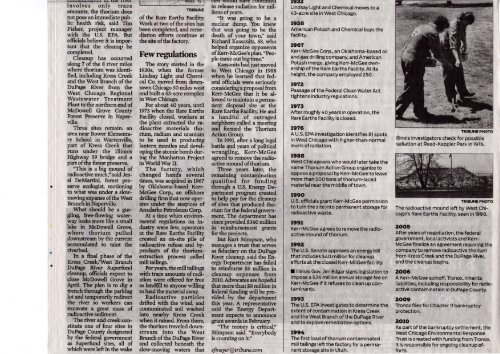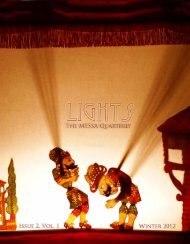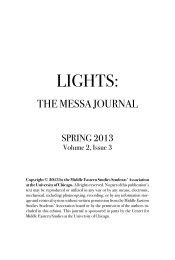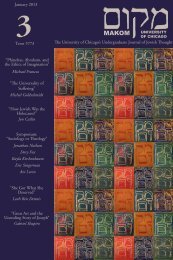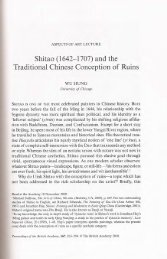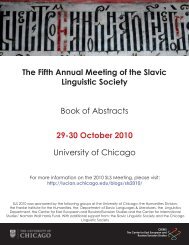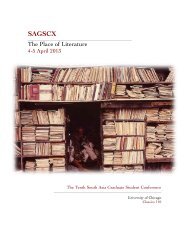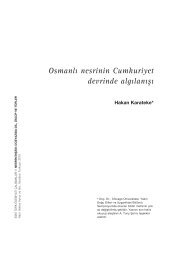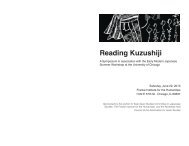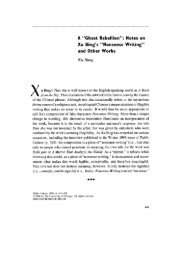A radioactive legacy lingers
A radioactive legacy lingers
A radioactive legacy lingers
Create successful ePaper yourself
Turn your PDF publications into a flip-book with our unique Google optimized e-Paper software.
involves only trace<br />
amounts, the thorium does<br />
notpose an immediate public<br />
health risk, said Tim<br />
Fisher, project manager<br />
with the U.S. EPA. But<br />
officials believe it is important<br />
that the cleanup be<br />
completed.<br />
Cleanup has occurred<br />
alongT of the 8 river miles<br />
where thorium was identified<br />
including Kress Creek<br />
and the West Branch of the<br />
DuPage River from the<br />
West Chicago Regional<br />
Wastewater Treatment<br />
Plantto the northern end of<br />
McDowell Grove County<br />
Forest Freserve in Naperville.<br />
Three sites remairu an<br />
area near Bower Elementary<br />
School in Warrenville,<br />
part of Kress Creek that<br />
runs under the Illinois<br />
Highway 59 bridge and a<br />
part ofthe forest preserve.<br />
"This is a big mound of<br />
<strong>radioactive</strong> muckj' said Jessi<br />
DeMartini, forest preserrre<br />
ecologist, motioning<br />
to what was under a slowmoving<br />
orpanse of the West<br />
Branchin Naperville.<br />
What should be a gurgling,<br />
free-flowing waterwaylooks<br />
more like asmall<br />
lake in McDowell Grove,<br />
where thorium pulled<br />
downstream by the current<br />
accrrmulated to taint the<br />
riverbed"<br />
In a final phase of the<br />
Iftess CreckAV'est Branch<br />
DuPage River Superfrrnd<br />
cleanup, officials srpect to<br />
close I\flcDorrell Grorre in<br />
April. The plan is to dig a<br />
tnench through the parking<br />
lot and temporarily dir€ct<br />
the river so worlens can<br />
errcavate a gfeat mass of<br />
<strong>radioactive</strong> sediment<br />
The river and creek constittrte<br />
one of four sites in<br />
DuPage County desigrrated<br />
by the federal government<br />
as Superfund sites, all of<br />
whichwere left inthe wake<br />
['' ';'t-'Mlles t^ 1'<br />
TRIBUNE<br />
of the Rare Earttr Facility.<br />
Work at two of the sites has<br />
been completed and remediation<br />
efforts continue at<br />
the site ofthe factory.<br />
Few regulations<br />
The story started in the<br />
1930s, when the former<br />
Lindsay Light and Chemical<br />
Co. moved from downtown<br />
Chicago 30 miles west<br />
and built a +g-acre complex<br />
inWestChicago.<br />
For about 4O years, until<br />
1973 when the Rare Earths<br />
Facility closed workers at<br />
the plant entracted the <strong>radioactive</strong><br />
materials thoriurr\<br />
radium and uranium<br />
to be used in producing<br />
lantern mantles and developingthe<br />
atomic bomb during<br />
the Manhattan Project<br />
inWorldwaru.<br />
The factory, which<br />
changed hands several<br />
timeq was acqtrired n1967<br />
by OHahoma-based Kerr-<br />
Mccree Corp., an ofthore<br />
drilingfim that now operates<br />
under the auspices of<br />
Anadarko Fetroleum Corp.<br />
At a time when environmental<br />
negulations on indusfy<br />
urere few, operators<br />
at the Rare Earths Facility<br />
created an on-site pile of<br />
<strong>radioactive</strong> refuse and byproducts<br />
of the thoriumsrtraction<br />
process called<br />
miUtailins.<br />
For years, the mil tailings<br />
with trace afirounts of radiation<br />
were ofered for free<br />
as landfillto anyone willing<br />
to haul the material away.<br />
Radioactive partiiles<br />
drifted with the wind, and<br />
contaminated soil washed<br />
into nearby Kress Creek<br />
when it rained- From there,<br />
the thorium traveled dournstream<br />
into the West<br />
Branch of the DuPage River<br />
and collected beneath the<br />
slow-moving waters that<br />
to release radiation for millions<br />
ofyears.<br />
"It was going to be a<br />
nuclear dump. You knew<br />
that was going to be the<br />
death of your tournj' said<br />
Richard Kassanits, 58, who<br />
helped organize opponents<br />
of Kerr-McGee's plan. "People<br />
came outbigtime."<br />
Kassanits had just moved<br />
to West Chicago in f988<br />
when he learned that federal<br />
ofEcials were seriously<br />
considering a proposal from<br />
Kerr-McGee that it be allowed<br />
to maintain a permanent<br />
disposal site at the<br />
Rare Earths Facility. ffe and<br />
a handful of outraged<br />
neighbors called a meeting<br />
and formed the Thorium<br />
ActionGroup.<br />
In 1991, after a long legal<br />
battle and years ofpolitical<br />
wrangling, Kerr-McGee<br />
agreedto remove the <strong>radioactive</strong><br />
mound of thorium.<br />
Three years later, the<br />
remaining contamination<br />
qualified for funding<br />
tlrough a U.S. Energy Depafixnent<br />
program c.reated<br />
tq help pay for the cleanup<br />
of sites that produced thorium<br />
forthe federal government.<br />
The departnent has<br />
since prcvided $a+O million<br />
in reimbursement grants<br />
for the projects.<br />
But Iturt Stimpson, who<br />
nranages a trust that serves<br />
as fiduciary on the DuPage<br />
River cleanup, said the Energy<br />
Departrnent has failed<br />
to reimburse $5 million in<br />
cleanup expenses from<br />
2O1O. Mvocates are hopefrrl<br />
that more than $8 million in<br />
Heral fundingwill be provided<br />
by the departrnent<br />
this year. A representathre<br />
said the Energy Department<br />
expects to announce<br />
grant4wards in February.<br />
"The money is critical,"<br />
Stimpson said. "Everybody<br />
is countingon if'<br />
efineyer@tribune.com<br />
193Z<br />
Lindsay Light and Chemical moves to a<br />
43-acre site in West Chicago.<br />
1958<br />
American Potash and Chemical buys the<br />
facility.<br />
t967<br />
Kerr-McGee Corp., an Oklahoma-based oil<br />
and gas drilling company, and Amerlcan<br />
Potash merge, giving Kerr-McGee ownership<br />
of the Rare Earths Facility. At lts<br />
height, the company employed 25O.<br />
t9'ti2<br />
Passage of the Federal Clean Water Act<br />
tightens industry regulations.<br />
1973<br />
After roughly 40 years in operation, the<br />
Rare Earths Facility is closed.<br />
1976<br />
A U.S. EPA investlgation identifles 81 spots<br />
in West Chicago with higher-than-normal<br />
levels of radiation.<br />
1988<br />
West Chlcagoans who would later take the<br />
name Thorlum Action Group organize to<br />
oppose a proposal by Kerr-McGee to leave<br />
more than 50O tons of thorium-laced<br />
materlal nearthe middle of town.<br />
1990<br />
U.S. offlclals grant Kerr-McGee permission<br />
to turn the site lnto permanent storage for<br />
radloactive waste.<br />
.1991<br />
Kerr-McGee agrees to remove the radloactive<br />
mound of thorium.<br />
1992<br />
The U.S. Senate approves an energy blll<br />
that lncludes $40 million for cleanup<br />
efforts at the closed Kerr-McGee facility.<br />
I lllinols Gov. Jlm Edgar signs leglslatlon to<br />
impose a $26 million annual storage fee on<br />
Kerr-McGee if lt refuses to clean up contamlnants.<br />
1993<br />
The U.S. EPA lnvestigates to determlne the<br />
extent of contaminatlon in Kress Creek<br />
and the West Branch of the DuPage Rlver<br />
and to explore remediatlon optlons.<br />
1994<br />
The first load of thorium contaminated<br />
mill tailings left the factory for a permanent<br />
storage site in Utah.<br />
TRIBUNE PHOTO<br />
lllinols investigators check for posslble<br />
radiation at Reed-Keppler Park ln 1976.<br />
TRIBUNE PHOTO<br />
The radloactlve mound left by West Chlcago's<br />
Rare Earths Facility, seen ln'1990.<br />
2005<br />
After years of negotiation, the federal<br />
government, local activists and Kerr-<br />
McGeeflnallze an agreement requlrlngthe<br />
company to remove radloactive thorlum<br />
from Kress Creek and the DuPage Rlver,<br />
and the cleanup beglns.<br />
2006<br />
A Kerr-McGee splnoff, Tronox, lnherlts<br />
liablllties, lncludlng responsibillty for radloactlve<br />
contaminatlon in DuPage County.<br />
2009<br />
Tronox flles for Chapter 11 bankruptcy<br />
protectlon.<br />
2010<br />
A,s part of the bankruptcy settlement, the<br />
West Chlcago Envlronmental Response<br />
Trust is created with funding from Tronox.<br />
It is responslble for ongoing cleanup efforts.<br />
l


